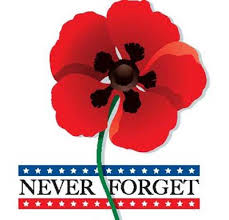Today is Veteran’s Day 11/11, so I would be remiss without honoring my father, birthfather, grandparents, as well as all our nation’s heroes for their unselfish service to our country. Although I was aware of the poppy’s association with this day, I was not fully knowledgeable of the symbolism until reading this explanation:
“Ever wonder why Veterans day is on the 11th and does not change? World War I ended on the 11th month on the 11th day on the 11th hour. Today I saw a man selling poppies stop a lady and asked if he could re-position her poppy. While doing so he told that lady she should wear the poppy on the right side; the red represents the blood of all those who gave their lives, the black represents the mourning of those who didn’t have their loved ones return home, and the green leaf represents the grass and crops growing and future prosperity after the war destroyed so much. The leaf should be positioned at 11 o’clock to represent the eleventh hour of the eleventh day of the eleventh month, the time that World War I formally ended.”
“In Flanders Fields” by John McCrae
In Flanders fields the poppies blow
Between the crosses, row on row,
That mark our place; and in the sky
The larks, still bravely singing, fly
Scarce heard amid the guns below.
We are the Dead. Short days ago
We lived, felt dawn, saw sunset glow,
Loved and were loved, and now we lie
In Flanders fields.
Take up our quarrel with the foe:
To you from failing hands we throw
The torch; be yours to hold it high.
If ye break faith with us who die
We shall not sleep, though poppies grow
In Flanders fields.
The History Channel website also provided some background on the inspiration of this poem:
The Remembrance Day symbolism of the poppy started with a poem written by a World War I brigade surgeon who was struck by the sight of the red flowers growing on a ravaged battlefield.
Across northern France and Flanders (northern Belgium), the brutal clashes between Allied and Central Powers soldiers tore up fields and forests, tearing up trees and plants and wreaking havoc on the soil beneath. But in the warm early spring of 1915, bright red flowers began peeking through the battle-scarred land: Papaver rhoeas, known variously as the Flanders poppy, corn poppy, red poppy and corn rose. As Chris McNab, author of “The Book of the Poppy,” wrote in an excerpt published in the Independent, the brilliantly colored flower is actually classified as a weed, which makes sense given its tenacious nature.
Lieutenant Colonel John McCrae, a Canadian who served as a brigade surgeon for an Allied artillery unit, spotted a cluster of poppies that spring, shortly after the Second Battle of Ypres. McCrae tended to the wounded and got a firsthand look at the carnage of that clash, in which the Germans unleashed lethal chlorine gas for the first time in the war. Some 87,000 Allied soldiers were killed, wounded or went missing in the battle (as well as 37,000 on the German side); a friend of McCrae’s, Lieutenant Alexis Helmer, was among the dead.
Struck by the sight of bright red blooms on broken ground, McCrae wrote a poem, “In Flanders Field,” in which he channeled the voice of the fallen soldiers buried under those hardy poppies. Published in Punch magazine in late 1915, the poem would be used at countless memorial ceremonies, and became one of the most famous works of art to emerge from the Great War. Its fame had spread far and wide by the time McCrae himself died, from pneumonia and meningitis, in January 1918.
Thank you all for your service.

Leave a Reply